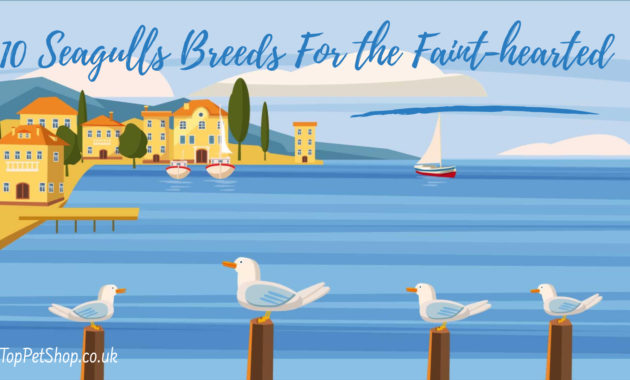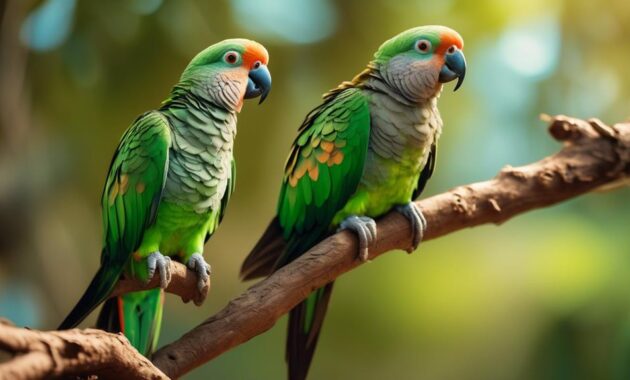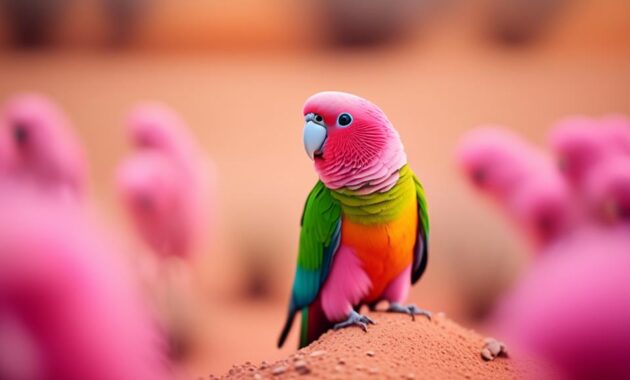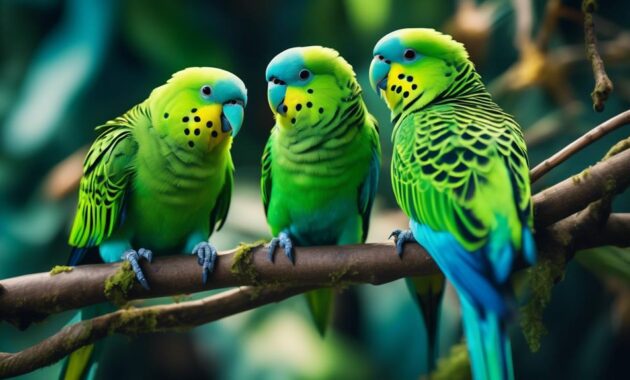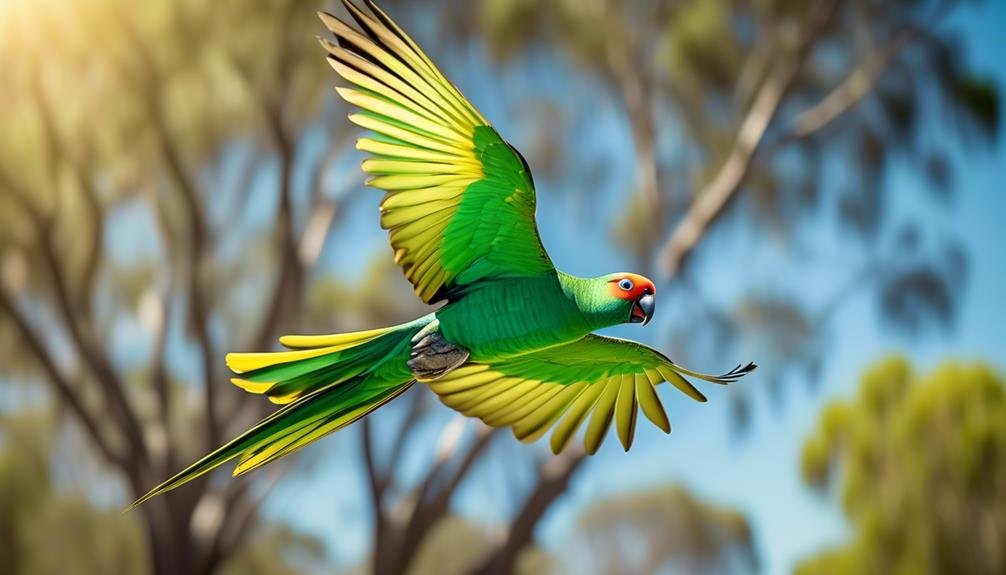
Are you ready to witness the breathtaking allure of the Mallee Ringneck Parrot?
This extraordinary parrot species, part of the Barnardius family, astounds with its vibrant palette of colors and unique attributes. With its sleek physique, small head, and beak, the Mallee Ringneck is a true spectacle.
But that’s just the beginning. There’s so much more to this captivating creature that will leave you yearning for more.
Key Takeaways
- The Mallee Ringneck Parrot is a small parrot species with an average length of 15-17 inches and a lifespan of approximately 15 years.
- They are mainly found in Central Australia and inhabit various environments such as water valleys, woodlands, shrublands, and areas with Eucalyptus growth.
- The vibrant colors of the Mallee Ringneck Parrot provide camouflage and make them a common sight in suburban areas, where they coexist with humans and take advantage of backyard bird feeders.
- While their presence in suburban areas is admired for their vibrant colors and playful behavior, they can also cause significant damage to agricultural crops and compete with farmers for food and water.
Size and Lifespan
The Mallee Ringneck Parrot is a vibrant and captivating bird species. It is known for its average length of 15-17 inches and a lifespan of approximately 15 years. With a small head and beak, and a long and tapered broad tail, these parrots are part of the Barnardius family.
Weighing around 5 ounces on average, they are a popular breed in aviculture. They are commonly seen as pets in England and Europe, although still rare in the USA. Found in Central Australia, their natural habitat includes water valleys, woodlands, shrubland, and Eucalyptus growth. They can even be spotted in suburban areas, although they are considered pests on agricultural properties.
When it comes to their speech, they have moderate vocalizations. Their natural calls consist of melodious whistles and chirps. During courting season, the males can become quite loud. As for their appearance, they boast a stunning array of colors. They have a mostly light green body, touches of yellow, a blue-black back and wings, and a red band above the beak.
Description and Physical Features
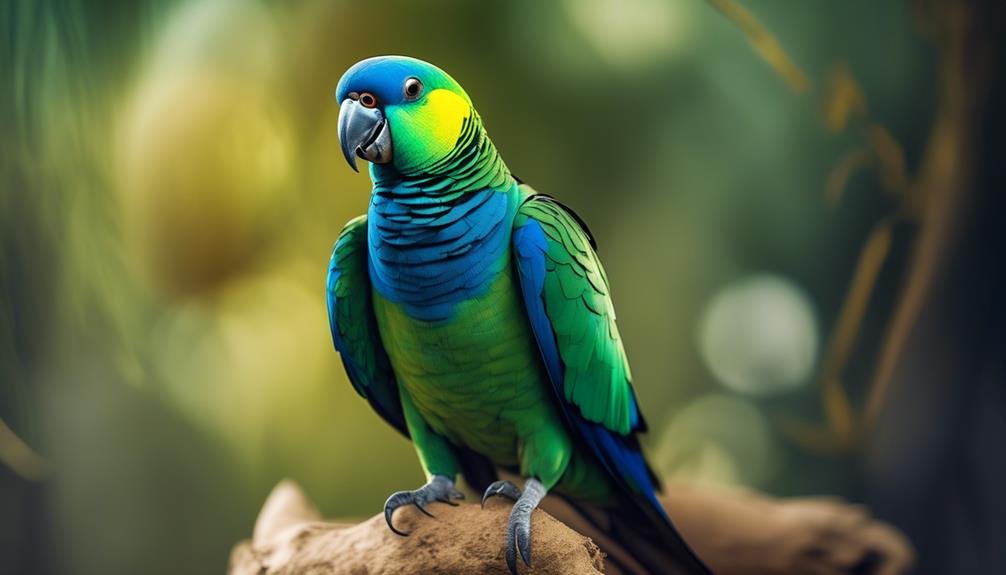
Now let’s take a closer look at the description and physical features of the Mallee Ringneck Parrot.
This parrot species, belonging to the Barnardius family, has a small head and beak, along with a long and tapered broad tail. It has an average length of 15-17 inches and weighs around 5 ounces.
The Mallee Ringneck Parrot stands out with its stunning array of colors. Its body is mostly light green with touches of yellow, while its back and wings are blue-black. It also has a distinctive red band above its beak.
Found in Central Australia, this parrot can be seen in various habitats such as water valleys, woodlands, shrubland, and Eucalyptus growth.
It’s known for its moderate vocalizations, which include melodious whistles and chirps. During the courting season, the males can become quite loud.
The Mallee Ringneck as a Parrot Species
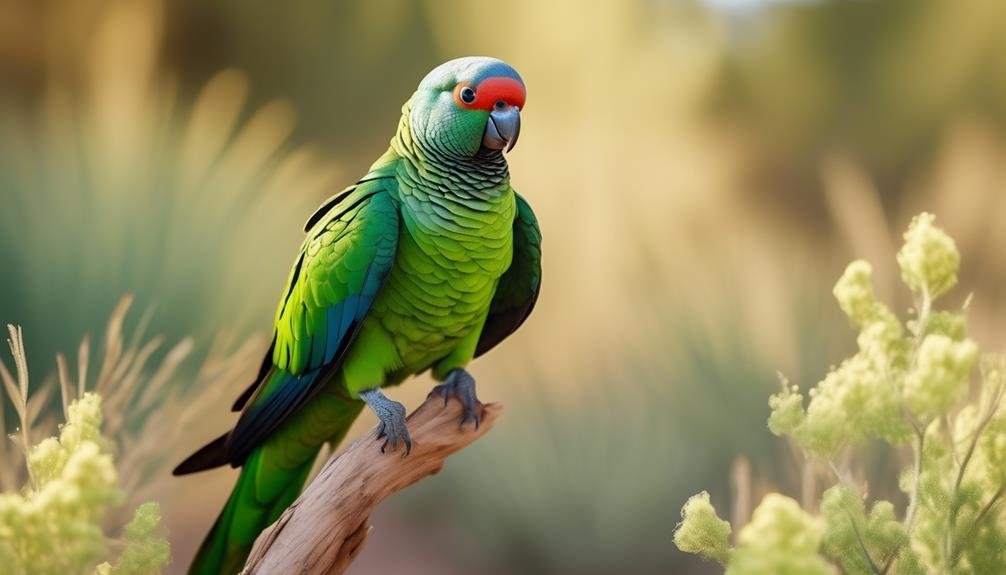
Mallee Ringneck Parrots, a popular breed in aviculture, belong to the parrot family and have distinct breeds within the species. First bred in captivity in 1909, they’ve become a popular choice for pet owners in England and Europe, although they’re still relatively rare in the USA.
These parrots are known for their stunning array of colors, with a body that’s mostly light green with touches of yellow, a blue-black back and wings, and a red band above the beak. They’ve a small head and beak, and a long, tapered broad tail.
With an average length of 15-17 inches and a lifespan of 15 years, Mallee Ringneck Parrots make fascinating and beautiful additions to any aviary or home.
Breeding History and Popularity
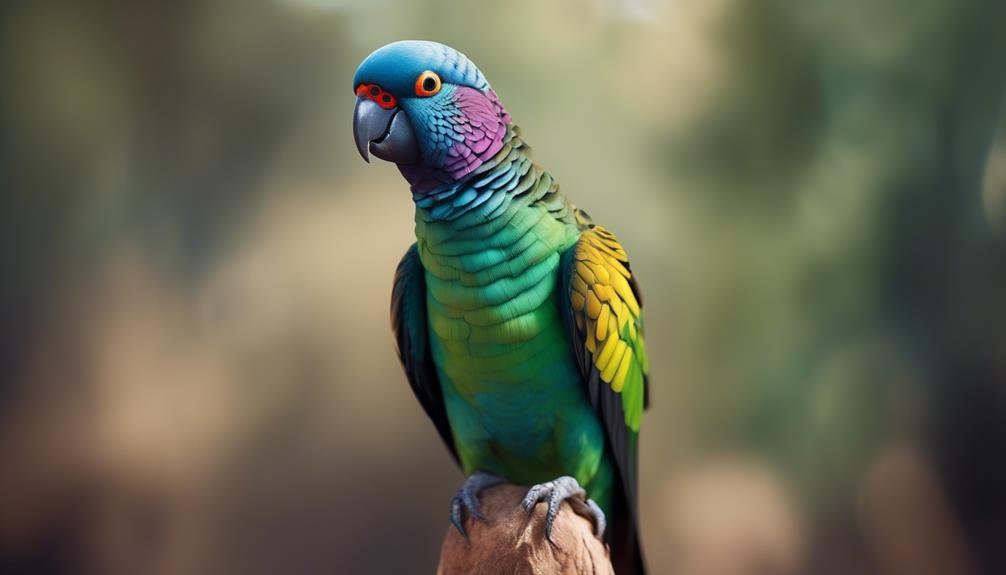
With their captivating colors and unique characteristics, Mallee Ringneck Parrots have gained significant popularity in aviculture. Here are four reasons why they’ve become a sought-after breed:
- Breeding History: Mallee Ringneck Parrots were first bred in captivity in 1909, making them one of the earliest parrot species to be successfully bred. This long history of captive breeding has allowed for the development of distinct breeds within the species, further increasing their popularity.
- Avicultural Appeal: Their vibrant colors and striking appearance make Mallee Ringneck Parrots a popular choice for bird enthusiasts. Their stunning array of colors, with a light green body, touches of yellow, blue-black back and wings, and a red band above the beak, make them a visually appealing addition to any aviary.
- Popularity in Europe: Mallee Ringneck Parrots are commonly seen as pets in England and Europe, where they’ve gained a loyal following among bird enthusiasts. However, they’re still considered rare in the United States, adding to their appeal.
- Ease of Care: Mallee Ringneck Parrots are known for their adaptability and relative ease of care, making them suitable for both experienced and novice bird keepers. Their moderate vocalizations and melodious whistles and chirps add to their charm, making them a delightful addition to any bird lover’s collection.
Geographic Range and Natural Habitat
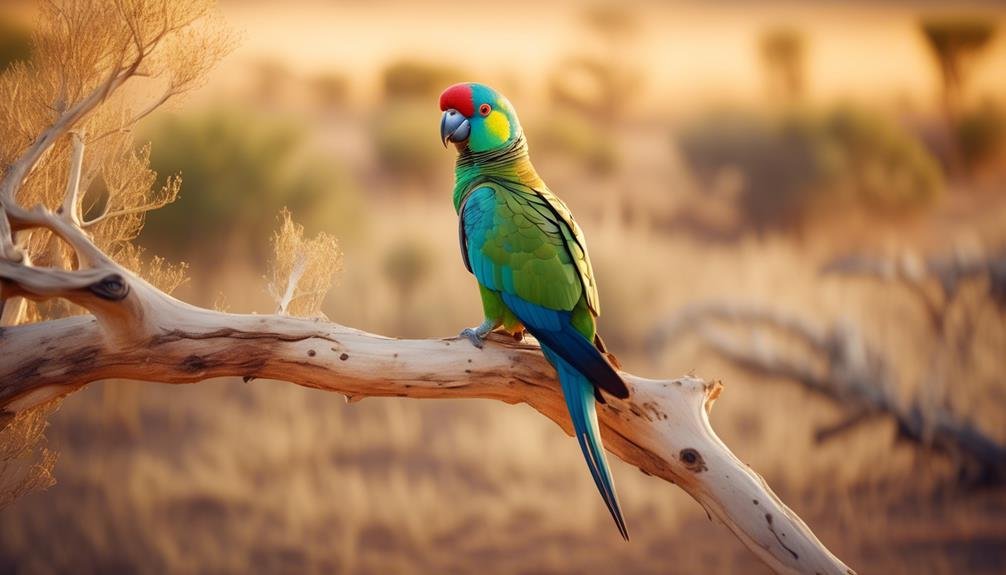
The Mallee Ringneck Parrot can be found in the Central Australia region, where it inhabits various types of habitats including water valleys, woodlands, shrubland, and areas with Eucalyptus growth.
These parrots are adaptable to different environments and can also be seen in suburban areas. However, they’re considered pests on agricultural properties due to their feeding habits.
The natural habitat of the Mallee Ringneck Parrot provides them with ample food sources and nesting opportunities. They’re able to thrive in these diverse habitats, making them well-suited to survive in the Central Australian region.
Whether it’s near a water valley or in the midst of Eucalyptus growth, the Mallee Ringneck Parrot continues to display its vibrant beauty in its natural habitat.
Habitat and Adaptations
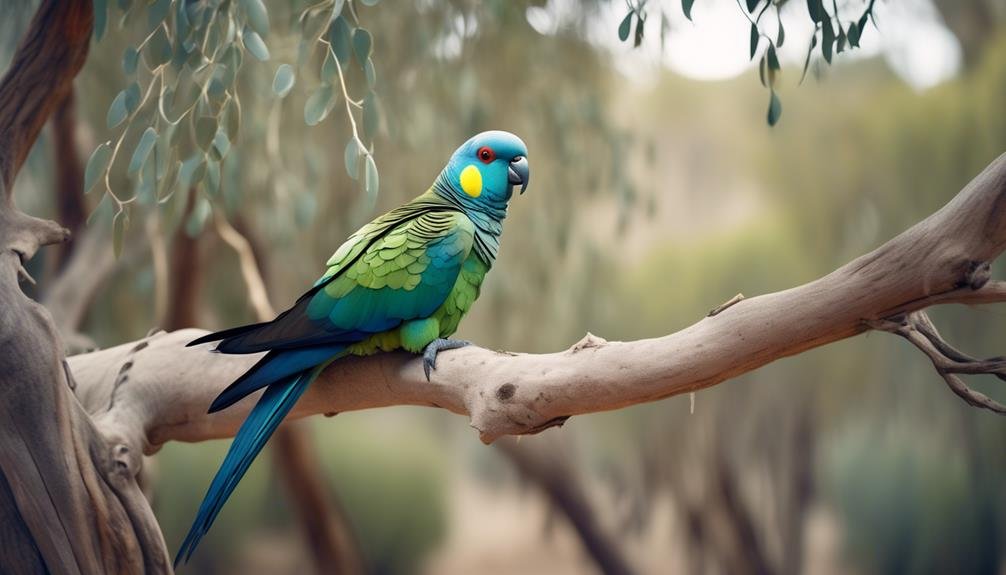
As we shift our focus to the topic of ‘Habitat and Adaptations’, let’s explore how the Mallee Ringneck Parrot thrives in diverse environments and has adapted to its natural surroundings.
Here are four fascinating facts about its habitat and adaptations:
- Versatility: The Mallee Ringneck Parrot is found in a variety of habitats, including water valleys, woodlands, shrublands, and areas with Eucalyptus growth. This adaptability allows the parrot to survive in different environments.
- Suburban Adaptation: Unlike many other parrot species, the Mallee Ringneck Parrot can also be seen in suburban areas. It has successfully adapted to human presence and can even thrive in urban environments.
- Pest Status: While the Mallee Ringneck Parrot is admired for its beauty, it’s considered a pest on agricultural properties. Its ability to adapt and find food sources has led to conflicts with farmers.
- Camouflage: The parrot’s vibrant colors may seem conspicuous, but they actually help it blend into its natural surroundings. The green body with touches of yellow, combined with the blue-black back and wings, provides camouflage in its habitat.
These adaptations enable the Mallee Ringneck Parrot to not only survive but also thrive in its diverse surroundings.
Presence in Suburban Areas
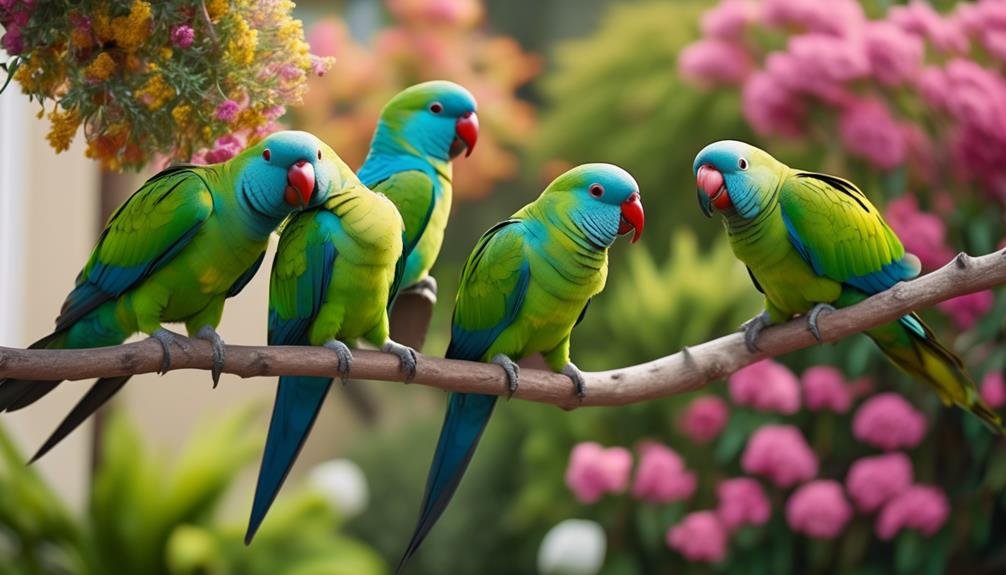
You may often spot the Mallee Ringneck Parrot in suburban areas, showcasing its remarkable adaptation to human presence. These parrots have shown a remarkable ability to thrive in urban environments, making them a common sight in gardens, parks, and even on residential streets.
Their vibrant colors and playful behavior make them a delightful addition to any suburban landscape. Despite their small size, Mallee Ringnecks aren’t easily overlooked, as their distinctive calls can often be heard echoing through the neighborhood.
They’ve learned to coexist with humans, taking advantage of backyard bird feeders and nesting in tree hollows or man-made structures. Their presence in suburban areas serves as a testament to their resilience and ability to adapt to changing environments.
Impact on Agricultural Properties
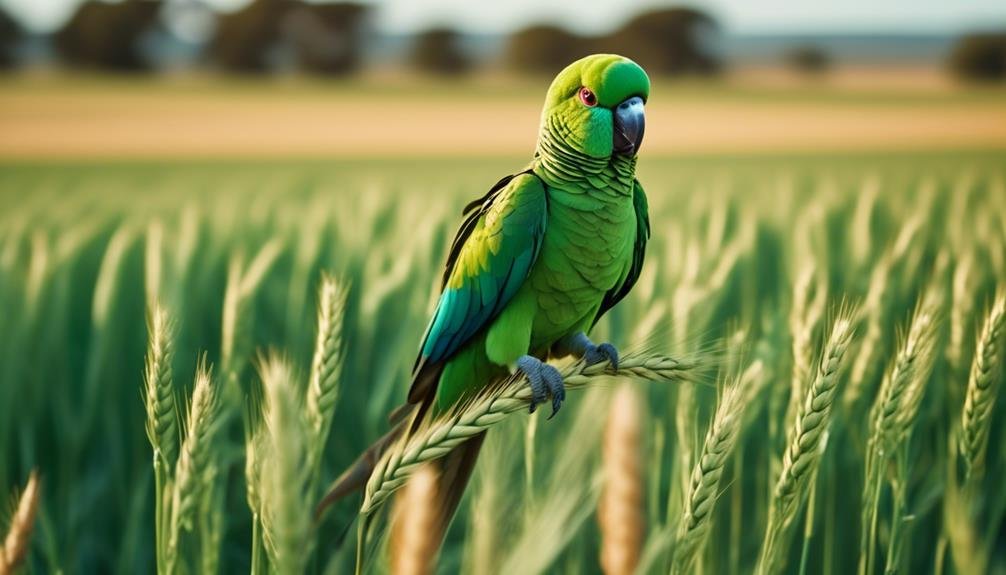
Mallee Ringneck Parrots have a significant impact on agricultural properties due to their feeding habits and foraging behavior. Here are four ways in which they affect agricultural properties:
- Crop damage: These parrots have a tendency to feed on agricultural crops such as grains, fruits, and vegetables, causing significant damage to farmers’ yields.
- Competition for food and water: Mallee Ringneck Parrots compete with livestock and other native birds for limited food and water resources on agricultural properties, potentially leading to reduced resources for livestock and reduced productivity.
- Nesting in buildings and machinery: These parrots often seek shelter in sheds, barns, and machinery on agricultural properties, leading to potential damage to infrastructure and equipment.
- Spread of weeds: Mallee Ringneck Parrots consume and disperse the seeds of various weeds, contributing to their spread across agricultural properties and making weed control more challenging for farmers.
Vocalizations and Communication
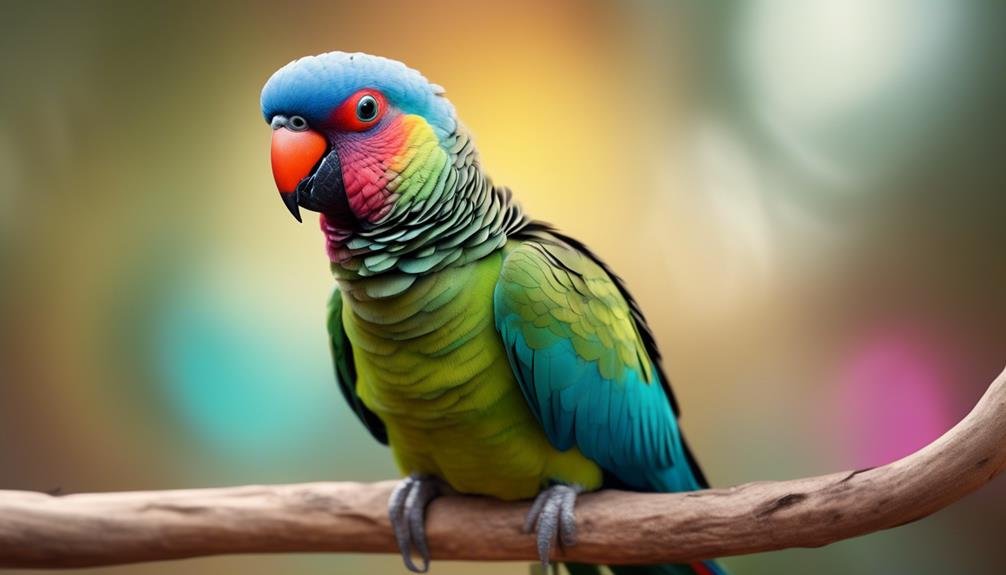
The vocalizations and communication of the Mallee Ringneck Parrot species are an essential aspect of their social interactions and daily life. These parrots have a diverse range of sounds that they use to communicate with each other and their environment. Here is a table showcasing some of their vocalizations:
| Vocalization | Description | Purpose |
|---|---|---|
| Melodious Whistle | Pleasant and melodic whistle-like sounds | Used for communication and social bonding |
| Chirp | Short and high-pitched chirping sounds | Indicates happiness or contentment |
| Loud Calls | Sharp and loud calls | Used during courting season or to establish territory |
| Squawk | Harsh and loud screeching sounds | Indicates danger or distress |
These vocalizations play a crucial role in the parrots’ daily activities, helping them communicate with their flock members, express their emotions, and establish their presence in their surroundings.
Natural Calls and Whistles
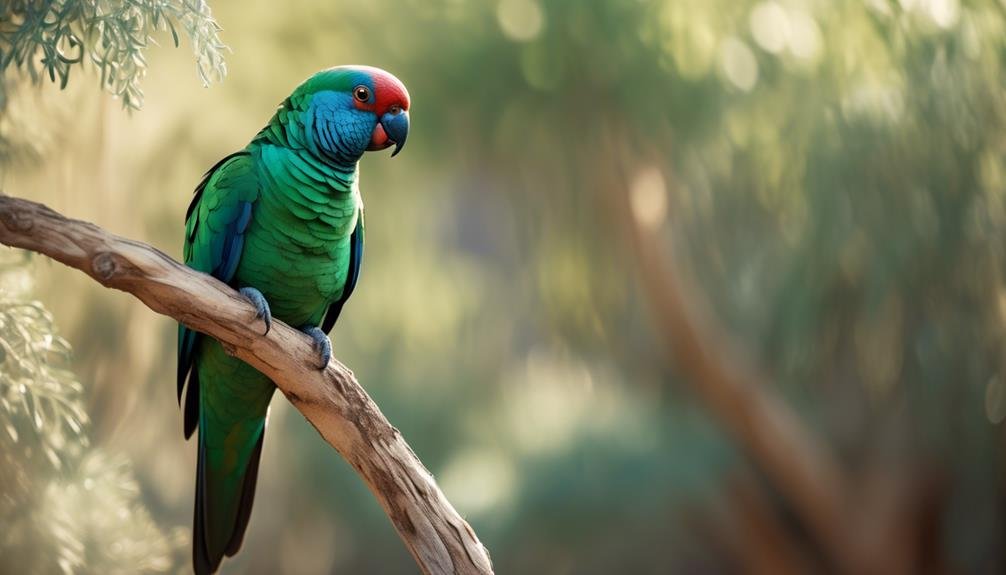
As we shift our focus to the subtopic of ‘Natural Calls and Whistles’, let’s explore the captivating sounds that the Mallee Ringneck Parrot species uses for communication and social bonding.
Here are the four interesting facts about the Mallee Ringneck Parrot’s natural calls and whistles:
- Melodious Whistles: The Mallee Ringneck Parrot is known for its melodious whistles and chirps. These sounds are a common form of communication among the species.
- Vocal Males: During the courting season, male Mallee Ringneck Parrots can become quite loud. They use their vocalizations to attract mates and establish their territory.
- Social Bonding: The natural calls and whistles of the Mallee Ringneck Parrot also play an important role in social bonding. These sounds help strengthen the relationships between individuals within their flock.
- Moderate Vocalizations: While the Mallee Ringneck Parrot isn’t known for constant chatter, they do engage in moderate vocalizations. These sounds add to the vibrant and lively atmosphere of their natural habitat.
The natural calls and whistles of the Mallee Ringneck Parrot contribute to their beauty and unique characteristics as a species.
Courtship Behavior and Male Vocalizations
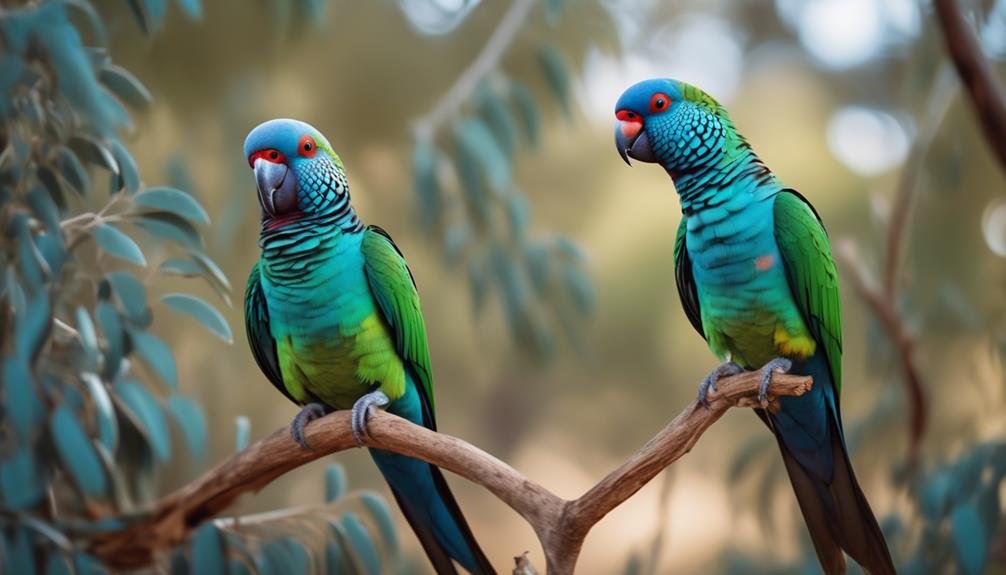
During courtship, male Mallee Ringneck Parrots showcase their vibrant colors and use vocalizations to attract potential mates. These parrots are known for their stunning array of colors, with a body mostly light green with touches of yellow, a blue-black back and wings, and a red band above the beak. To further captivate their potential mates, male Mallee Ringnecks engage in various courtship behaviors, accompanied by loud vocalizations. They may puff up their feathers, bob their heads, and perform elaborate displays of flying and hopping. The male’s vocalizations during courtship consist of melodious whistles and chirps, which can be quite loud and energetic. This combination of visual and auditory displays is essential in the mating process of Mallee Ringneck Parrots, ensuring successful reproduction and continuation of the species.
| Courtship Behaviors | Male Vocalizations |
|---|---|
| Puffing up feathers | Melodious whistles |
| Bobbing head | Chirps |
| Elaborate displays | Energetic calls |
| Flying and hopping | Loud vocalizations |
Colors and Plumage
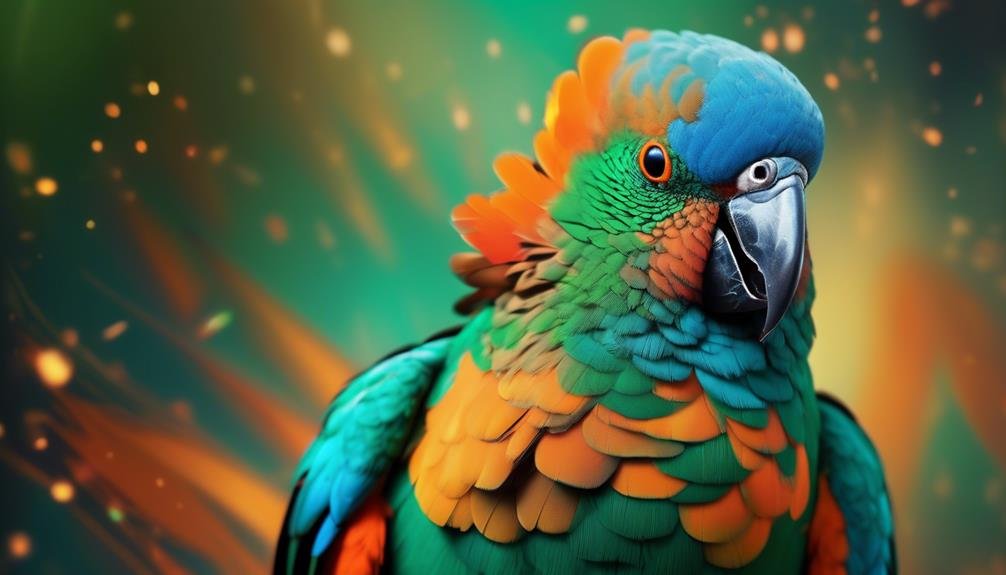
Male Mallee Ringneck Parrots captivate potential mates not only with their courtship behaviors and vocalizations but also through their stunning colors and plumage. Here are four remarkable features of their appearance:
- Vibrant green body: The Mallee Ringneck’s body is predominantly light green, which gives it a fresh and lively appearance. This color symbolizes vitality and growth.
- Striking blue-black back and wings: Contrasting with the green body, the Mallee Ringneck’s back and wings are adorned with a rich blue-black color. This adds depth and elegance to its overall appearance.
- Eye-catching red band above the beak: A distinct feature of the Mallee Ringneck is the vibrant red band that sits just above its beak. This splash of color draws attention to its face and adds a touch of boldness.
- Touches of yellow: Completing the colorful palette, the Mallee Ringneck has subtle touches of yellow scattered throughout its plumage. These yellow accents create a harmonious blend of colors, enhancing its beauty.
With their mesmerizing colors and exquisite plumage, male Mallee Ringneck Parrots are truly a sight to behold.
Predominant Green Body With Color Accents
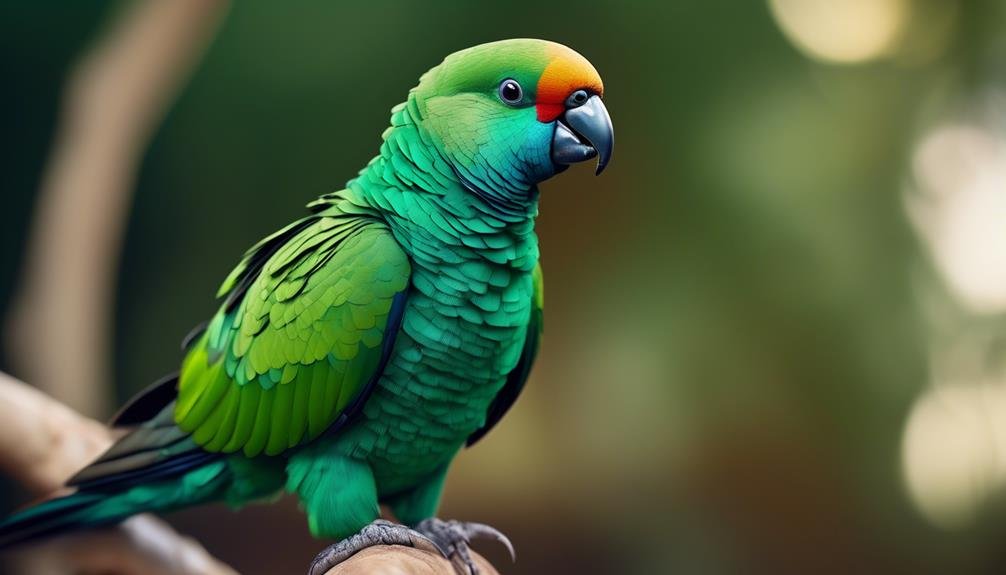
The Mallee Ringneck Parrot captivates with its predominant green body, adorned with vibrant color accents. These parrots have a stunning array of colors that make them stand out in the avian world. Their body is mostly light green, giving them a fresh and vibrant appearance.
But it’s the touches of yellow, blue-black back and wings, and a red band above the beak that truly make them eye-catching. These color accents add depth and contrast to their overall appearance, creating a visual spectacle that’s hard to ignore.
Whether they’re perched on a tree branch or flying through the sky, the Mallee Ringneck Parrot’s green body with colorful accents is a sight to behold.
Unique Red Band Above the Beak
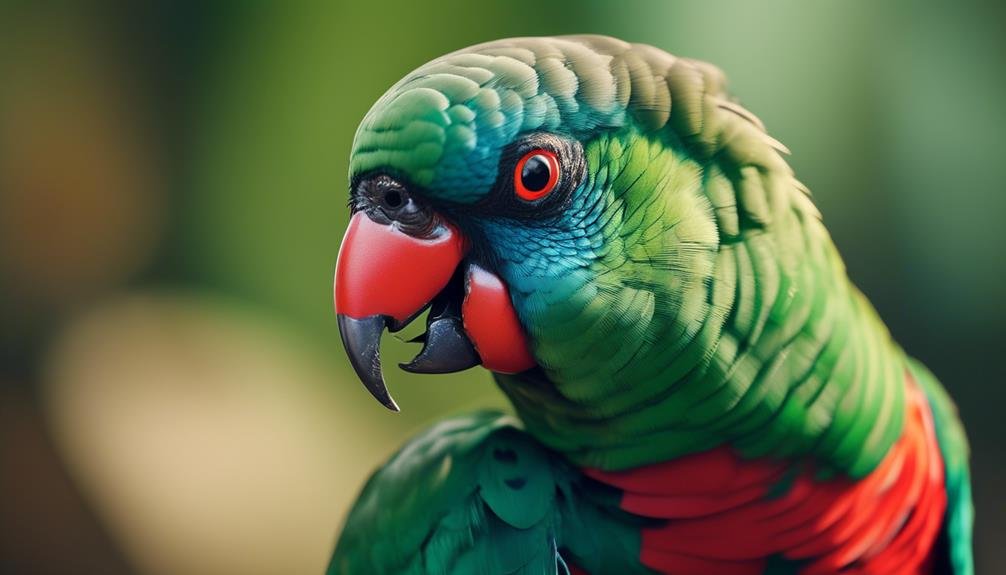
One distinctive feature of the Mallee Ringneck Parrot is the red band that rests above its beak. This unique red band adds a pop of color to the bird’s stunning appearance.
Here are four fascinating facts about this striking feature:
- Sign of maturity: The red band above the beak is more prominent in adult Mallee Ringneck Parrots. It serves as a visual indicator of their maturity and readiness for breeding.
- Individual variation: Each Mallee Ringneck Parrot has its own unique pattern and shade of red on the band. This individual variation adds to the bird’s overall beauty and charm.
- Courtship display: During courtship, the male Mallee Ringneck Parrot uses its red band to attract a mate. It fluffs up its feathers and displays the vibrant red band as a signal of its desirability.
- Identification marker: The red band above the beak also helps researchers and bird enthusiasts in identifying different subspecies and variations within the Mallee Ringneck Parrot population.
The red band above the beak truly sets the Mallee Ringneck Parrot apart and adds to its vibrant beauty.
Frequently Asked Questions
How Do Mallee Ringneck Parrots Adapt to Their Natural Habitat in Central Australia?
Mallee Ringneck parrots adapt to their natural habitat in central Australia by living in water valleys, woodlands, shrubland, and Eucalyptus growth. They can also be seen in suburban areas and are considered pests on agricultural properties.
What Is the Significance of the Red Band Above the Beak in Mallee Ringneck Parrots?
The red band above the beak in Mallee Ringneck parrots serves as a distinguishing feature. It adds to their vibrant beauty and helps in identifying them.
Are Mallee Ringneck Parrots Commonly Kept as Pets in the United States?
No, Mallee Ringneck parrots are still rare as pets in the USA. They are, however, commonly seen as pets in England and Europe. They belong to the parrot family and are popular in aviculture.
How Does the Mallee Ringneck Parrot’s Breeding History Contribute to Its Popularity in Aviculture?
The Mallee Ringneck Parrot’s breeding history contributes to its popularity in aviculture. The species was first bred in captivity in 1909 and has since become a popular breed in aviculture, especially in England and Europe.
What Are Some Common Misconceptions About Mallee Ringneck Parrots’ Vocalizations and Communication?
Some common misconceptions about Mallee Ringneck parrots’ vocalizations and communication include thinking they are always loud and noisy. In reality, they have moderate vocalizations with melodious whistles and chirps, only becoming loud during courting season.
What are the similarities and differences between the Mallee Ringneck Parrot and the Princess Parrot?
The Mallee Ringneck Parrot and the Princess Parrot share similar vibrant plumage, especially in their breast and head feathers. However, the Princess Parrot vibrancy within discovery includes more pastel shades and a longer tail, while the Mallee Ringneck has a more predominant green color and a shorter tail.
Conclusion
So there you have it, the Mallee Ringneck Parrot is truly a stunning and captivating species. With its vibrant colors, unique characteristics, and melodious vocalizations, it’s no wonder that this parrot has become a popular breed in aviculture.
Whether you’re a bird enthusiast or simply appreciate the beauty of nature, the Mallee Ringneck is sure to amaze and inspire you. Join us on this journey of discovery and experience the vibrant beauty of the Mallee Ringneck Parrot for yourself.

